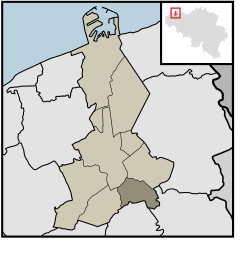Assebroek
| Assebroek | |
|---|---|
| Deelgemeente | |
 |
|
| Coordinates: 51°11′47″N 3°15′13″E / 51.19639°N 3.25361°E | |
| Country | Belgium |
| Province |
|
| Municipality | Bruges |
| Area | |
| • Total | 8.52 km2 (3.29 sq mi) |
| Population (2007) | |
| • Total | 19,341 |
| • Density | 2,270/km2 (5,900/sq mi) |
| Source: NIS | |
| Postal code | 8310 |
Assebroek is a suburb in the municipality and city of Bruges, Belgium. In 2004, Assebroek had 19,525 inhabitants. Since 1999, this number has hardly changed. Assebroek is home to 16.7% of Bruges’ population.
Through artefacts retrieved near Saint-Lucas hospital (and stored at Gruuthusemuseum in Bruges) we assume that the Leitje region was already inhabited in the Stone Age.
Aerial views of the Ver-Assebroekse meersen reveals an approximately 300 m-wide ring of ditches and rampart complex dating from the 5th century where the lords of Assebroek later built their castle.
Apparently around the 12th century, a lord called Boudewijn of Assebroek bought his domain – limited by Oostkamp, Oedelem, Michel van Hamme street, Astridlaan and Lorreinendreef - free from Sijsele.
The Assebroek municipality only consisted of some scattered maisonnettes and a mill along the old road to Ghent. Instigated by the lords of Assebroek, a local church and Engelendale convent were established.
Nowadays Assebroek includes 6 parishes: Immaculata (Ver-Assebroek), Assumpta, Saint Lutgardis, Saint Catharina, Saint Christopher, and Sacred Heart (Steenbrugge).
Before the 20th Century, the town's name was recorded as Ars(e)brouc, later becoming Asse.
Ars(e)brouc probably meant wetland with horses. The medieval Dutch Arse or Ors being horses and brouc meaning marsh. In medieval times, the Meersen area was surrounded by several inns all bearing horsenames of which only the ruin of The Flying Horse in Oedelem is still standing. Some sources claim Arse stands for ashes so that Assebroek would mean marsh surrounded by ashes.
Assebroek is situated on a lower sand plain south west of Bruges. Forming a typical polder landscape, in winter an area called Assebroekse Meersen, characterised by small grass fields separated by willow trees often gets flooded.
The Meersen area arose as prolongation within the so-called Flemish Valley. The slope contains sand, lime and peat deposits from the Holocene Epoch. Underneath the peat remains an approx. 30 cm marsh lime layer from the early Holocene. 10,000 years ago, this region was a real marsh.
...
Wikipedia
